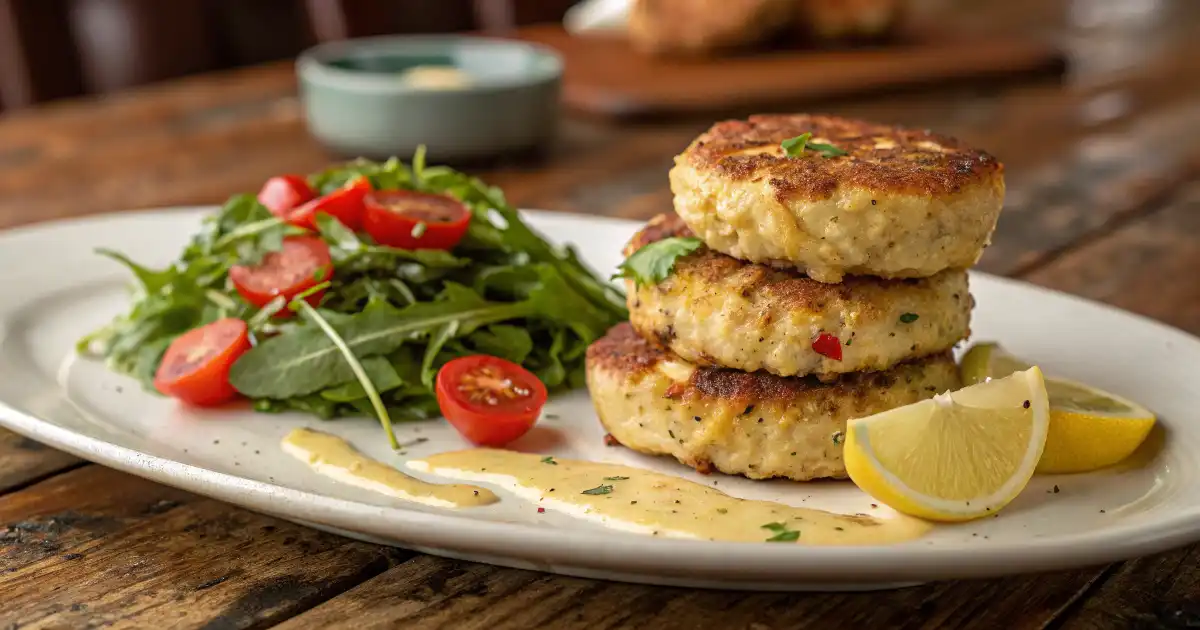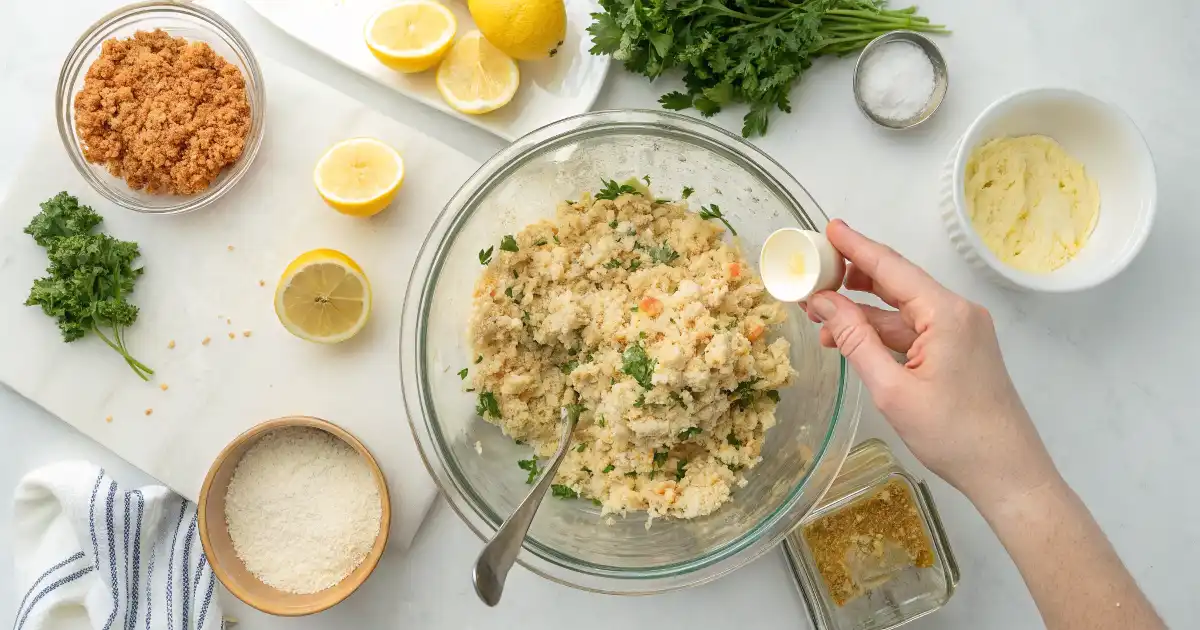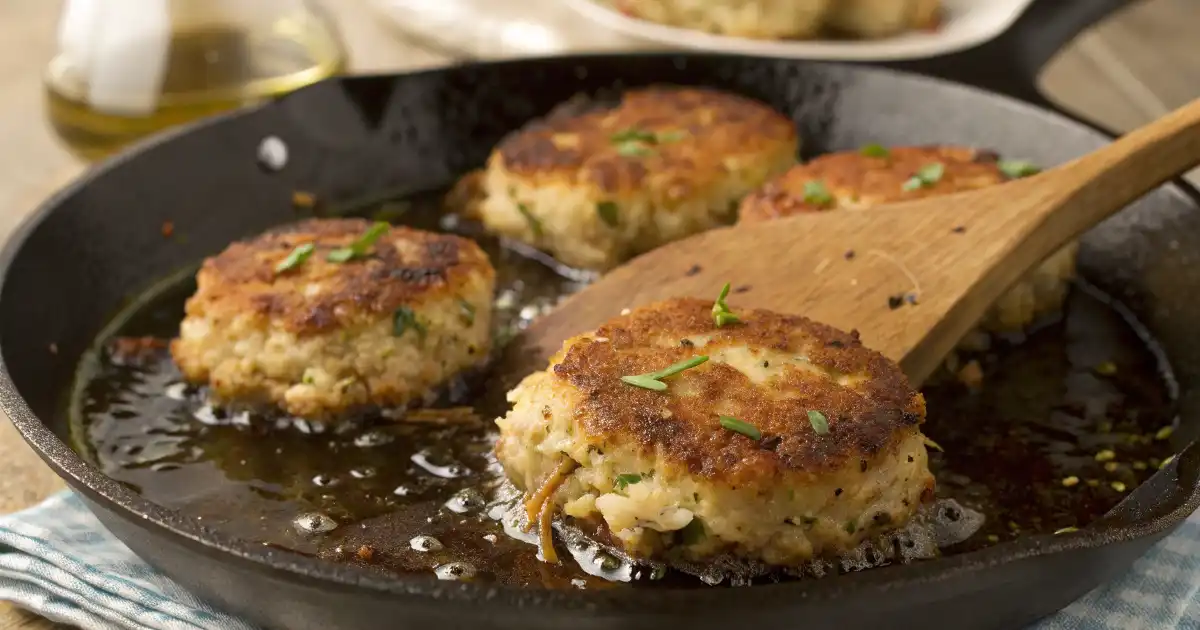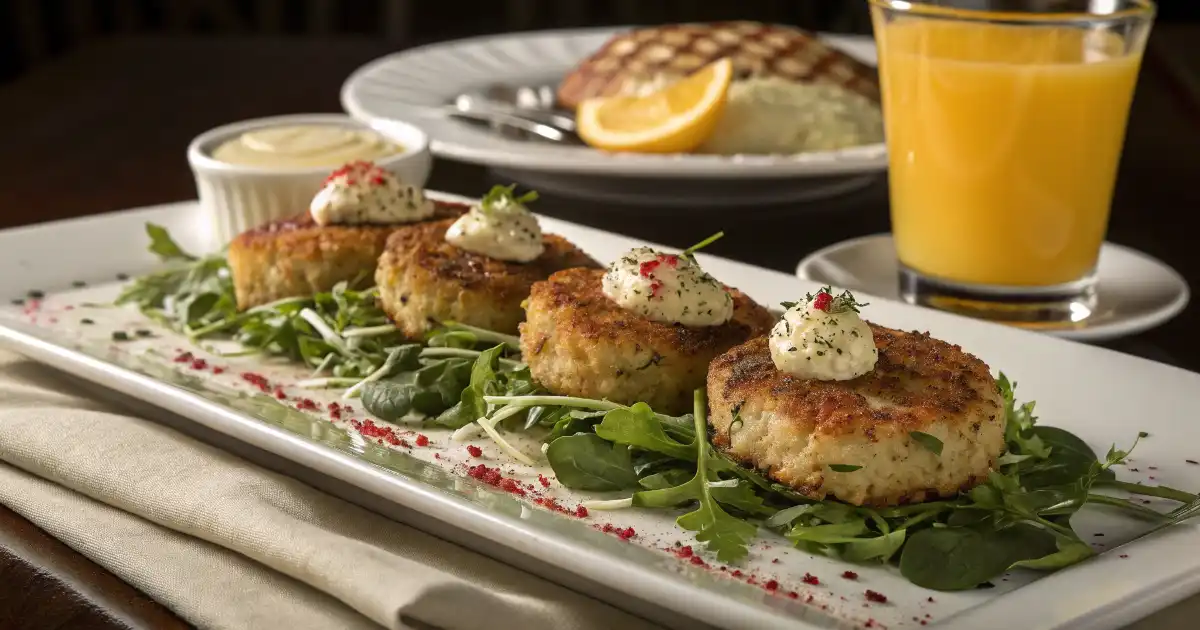This gluten free crab cake recipe lets you enjoy the savory goodness of crab without worrying about gluten. It’s made with real lump crabmeat and a few careful substitutions, ensuring a moist yet crisp texture. You’ll love how easy and flavorful these cakes are for any occasion.

Table of Contents
Introduction
Have you ever taken a bite of a perfectly crisp crab cake and instantly felt the ocean breeze on your tongue? There’s something magical about the combination of sweet, tender crab, warm spices, and a golden crust that somehow transports you straight to the shore. But what if you’re someone who’s actively avoiding gluten for health reasons, personal preference, or simply because you feel better when you skip wheat-based ingredients? Well, that’s where this fun, tasty, and downright irresistible gluten free crab cake recipe comes to the rescue!
By whipping up a batch of this gluten free crab cake recipe, you’re indulging in the same melt-in-your-mouth experience that seafood lovers can’t seem to get enough of—minus the gluten! Whether you’re dealing with celiac disease, gluten intolerance, or you’re just looking for lighter, more wholesome meal ideas, this article promises to give you everything you need to savor crab cakes, worry-free. If you’ve been craving that hearty taste of the sea but want to keep your diet on track, you’re in exactly the right place.
Get comfy, picture the salty ocean air, and let’s dive into all the details that will make this gluten free crab cake recipe your new go-to. From picking the freshest crabmeat to choosing the ideal gluten-free binder, you’ll learn it all step by step. And because we’ll cover everything from the best cooking methods to storing and reheating tips, you can feel confident every time you say, “Tonight, we’re having crab cakes!”
(Disclaimer: This article is for informational purposes only and does not replace professional veterinary advice or any form of specialized medical guidance. Always check with a qualified health professional about your dietary needs.)
Why Choose a gluten free crab cake recipe?
The most obvious perk of a gluten free crab cake recipe is that it allows anyone with a gluten sensitivity or intolerance to indulge. But even if you’re not strictly avoiding gluten, you may find that using gluten-free alternatives opens up a world of interesting textures and flavors. Traditional crab cakes often rely on breadcrumbs or crackers to hold them together, yet it’s entirely possible to replicate that mouthwatering taste and texture without gluten.
- Health Benefits
- When made with carefully chosen ingredients, a gluten free crab cake recipe can be lower in refined carbohydrates.
- Many people report feeling less bloated and more energized when cutting down on gluten.
- You’re still getting a hearty dose of protein and essential nutrients from the crab.
- Flavor and Texture
- Contrary to the stereotype, gluten-free cooking doesn’t have to be bland or dry.
- Choosing the right binders and seasonings can preserve the soft yet crunchy goodness.
- Techniques like baking, pan-searing, or air-frying can help you achieve different textures that still feel indulgent.
- Inclusive Dining
- By having a go-to gluten free crab cake recipe, you’ll be prepared to delight guests who might have dietary restrictions.
- It’s a perfect party option or family dinner choice that keeps everyone happy without sacrificing taste.
- Inclusivity goes a long way in making gatherings extra special and memorable.
By focusing on a tried-and-true gluten free crab cake recipe, you’ll soon master a dish that’s both comforting and impressive. After all, who says you need gluten to enjoy the very best of coastal cuisine?
Selecting Your Crabmeat
One of the greatest secrets to an incredible gluten free crab cake recipe is choosing the right crabmeat. The star of the show, crabmeat brings that briny, slightly sweet flavor that crab cakes are famous for. Whether you’re working with fresh crab just pulled from the shell, or you’re relying on quality canned or pasteurized crabmeat, it’s essential to know your options.
Types of Crabmeat
- Jumbo Lump Crabmeat
- Prized for its large, succulent chunks.
- Ideal for showcasing beautiful lumps in your crab cake.
- Often more expensive, but delivers an undeniable wow factor.
- Backfin or Lump Crabmeat
- Smaller pieces than jumbo lump, but still good quality.
- Typically less pricey, making it a solid choice for a large family dinner.
- Works well in a gluten free crab cake recipe because it mixes easily with binders.
- Claw Meat
- Darker and more intensely flavored than lump crabmeat.
- Often the most budget-friendly option.
- Slightly sweeter taste that can contrast deliciously with gluten free binders and spices.
Most grocery stores carry fresh or pasteurized crab in sealed containers. If you opt for the pasteurized version, check the sell-by date and pick the freshest container possible. Examine the crab for any bits of shell. Even though many brands remove shell fragments, it’s always wise to do a quick check to ensure nothing crunchy sneaks in.
Fresh vs. Frozen or Canned
- Fresh: Often the most flavorful, but can be hard to find and more expensive.
- Frozen: Usually flash-frozen soon after the crab is harvested, making it a good alternative if thawed properly.
- Canned or Pasteurized: Widely available, convenient, and typically has a long shelf life. Just be mindful of sodium content and always confirm you’re buying a brand you trust for quality.
Whenever you’re working with crabmeat, remember that it’s already cooked (if it’s fresh-picked or pasteurized). So, the aim of your gluten free crab cake recipe is primarily to enhance the flavor and crisp up the exterior rather than cooking the crab from raw.
Essential Ingredients for a gluten free crab cake recipe
Crafting a memorable gluten free crab cake recipe doesn’t have to be complicated. In fact, it often relies on just a handful of key ingredients—many of which you probably already have in your kitchen! Here’s a rundown of what you’ll need:
- Crabmeat: As discussed, choose jumbo lump, lump, or claw meat, depending on your budget and preference.
- Gluten-Free Binder: Options include gluten-free breadcrumbs, almond flour, ground oats (certified gluten-free), or crushed gluten-free crackers.
- Egg(s): Provides structure and helps bind everything together in your gluten free crab cake recipe.
- Mayonnaise: Adds moisture and richness. Choose a brand you love, or make your own.
- Mustard (Dijon or Spicy Brown): Gives a slight tangy note that complements crab’s sweetness.
- Worcestershire Sauce: Use a gluten-free brand to add depth of flavor.
- Seasonings: Old Bay seasoning is a timeless classic for crab cakes, blending paprika, celery salt, and other warm spices. Garlic powder, onion powder, black pepper, and salt also come in handy.
- Fresh Herbs: Parsley or chives add color and subtle brightness.
- Lemon Juice: A splash of citrus cuts through the richness.
- Cooking Oil or Butter: For sautéing or brushing on top if baking or air-frying.
When you gather this lineup for a gluten free crab cake recipe, you’re essentially ensuring that your final dish will be tender on the inside, crisp on the outside, and bursting with that succulent crab flavor. Remember to check all labels for hidden gluten, especially in condiments and seasonings, to keep your meal 100% free of gluten.
The Ultimate gluten free crab cake recipe (Step-by-Step)
Now, let’s get to the main event: the step-by-step directions for pulling off a mouthwatering gluten free crab cake recipe. Follow these instructions, and you’ll be digging into golden-brown crab cakes in no time!

Ingredients
- 1 pound lump crabmeat (picked over for shells)
- 1/2 cup gluten-free breadcrumbs (or almond flour)
- 1 large egg
- 2 tablespoons mayonnaise
- 1 tablespoon Dijon mustard
- 1 teaspoon Worcestershire sauce (ensure it’s gluten-free)
- 1 tablespoon fresh lemon juice
- 1 tablespoon finely chopped fresh parsley
- 1 teaspoon Old Bay seasoning (check for gluten-free)
- 1/2 teaspoon salt (or to taste)
- 1/2 teaspoon black pepper (or to taste)
- 2 tablespoons olive oil (or other cooking oil of your choice)
Instructions
- Mix the Wet Ingredients
- In a medium bowl, whisk together the egg, mayonnaise, Dijon mustard, Worcestershire sauce, lemon juice, Old Bay seasoning, salt, and pepper.
- This wet mixture is the flavorful backbone of your gluten free crab cake recipe.
- Fold in the Crab and Binder
- Gently add your crabmeat to the wet mixture, taking care not to break up the lumps too much.
- Next, sprinkle in the gluten-free breadcrumbs (or almond flour) and fold until everything holds together.
- Avoid overmixing; you want the crab to remain in chunks for that signature crab cake texture.
- Form Your Crab Cakes
- Using your hands, shape the mixture into patties that are about 3 inches in diameter and around an inch thick.
- You can create smaller bite-sized cakes if you plan to serve them as appetizers.
- Place the formed cakes onto a baking sheet or plate, and cover them with plastic wrap. Let them rest in the fridge for at least 30 minutes to firm up.
- Choose Your Cooking Method
- Pan-Searing: Heat the olive oil in a skillet over medium heat. Cook each crab cake for about 3–4 minutes on each side until golden brown.
- Baking: Preheat your oven to 400°F (200°C). Lightly oil a baking sheet, place the cakes on it, and bake for about 15–18 minutes or until they’re lightly browned on top.
- Air-Frying: Set your air fryer to 375°F (190°C). Spray the cakes with a little cooking spray and cook for about 10–12 minutes. Flip halfway for even browning.
- Serve and Enjoy
- Plate your crab cakes with a wedge of lemon or a dollop of gluten-free tartar sauce.
- Garnish with fresh parsley or chives for a pop of color.
- Savor your freshly prepared gluten free crab cake recipe and let that bright, briny flavor transport you to the beach!
Pro Tips for Making the Best gluten free crab cake recipe
- Chill Time: Don’t skip the step where you let the mixture rest in the fridge. This allows the flavors to meld and helps your cakes maintain their shape during cooking.
- Gentle Handling: The beauty of a gluten free crab cake recipe is the texture from big chunks of crab. Mix gently so you don’t turn it into mush.
- Binder Balance: If your mixture feels too wet, sprinkle in a touch more gluten-free breadcrumb or almond flour, but be cautious not to go overboard.
- Spice It Up: Feeling adventurous? Add a pinch of cayenne pepper or a dash of hot sauce for extra kick. Just make sure any additional ingredients align with the rest of the flavors.
- Oil Temperature: If pan-searing, let your oil get hot enough to sizzle but not smoke. A steady medium heat usually ensures the cakes cook through evenly and get that perfect golden crust.
Remember that a high-quality gluten free crab cake recipe relies on fresh crab, the right ratio of ingredients, and a careful cooking method. Once you get the hang of it, you’ll be able to whip these up even on a busy weeknight.
Serving Suggestions
A well-executed gluten free crab cake recipe is delightful on its own, but pairing it with the right sides and sauces can elevate your meal to restaurant quality.
- Sauces
- Tartar Sauce: A classic that never fails. Look for a gluten-free version or make your own with mayo, pickles, lemon, and a pinch of dill.
- Remoulade: Typically tangier than tartar sauce, with a bit of mustard and spices.
- Aioli Variations: Experiment with garlic aioli or even sriracha-infused aioli for a spicy twist.
- Side Dishes
- Green Salad: Keep it simple with mixed greens, cherry tomatoes, and a light vinaigrette.
- Coleslaw: The crunch of cabbage and carrots complements the soft interior of a crab cake.
- Roasted Vegetables: Asparagus, zucchini, or Brussels sprouts can be roasted until lightly caramelized.
- French Fries or Sweet Potato Fries: Because sometimes you just want that crispy, salty side.
- Beverage Pairings
- A crisp white wine like Pinot Grigio or Sauvignon Blanc.
- A light lager or pilsner if you’re a beer enthusiast (gluten-free beer works here too!).
- Sparkling water with fresh lemon or cucumber slices if you’d rather keep it non-alcoholic.
With a properly planned plate, your gluten free crab cake recipe can look as good as it tastes. Whether you’re hosting friends for dinner or simply treating yourself on a random Tuesday, these serving ideas ensure a well-rounded, savory experience.

Storage & Reheating Tips
One of the best parts about cooking a gluten free crab cake recipe at home is having extras for the next day’s lunch or a quick snack. Proper storage and reheating, however, can make a significant difference in how your leftovers taste.
- Refrigeration
- After cooking, allow the crab cakes to cool to room temperature.
- Transfer them into an airtight container or wrap them in foil.
- Store in the refrigerator for up to 3 days.
- Freezing
- Place uncooked or cooked crab cakes on a parchment-lined tray and freeze until they’re solid (about 2 hours).
- Then transfer them into a freezer-safe container or zip-top bag, separating layers with parchment.
- They will keep well for up to 2 months. Thaw overnight in the fridge before cooking or reheating.
- Reheating
- Oven: Preheat to 350°F (175°C). Place crab cakes on a baking sheet, and heat for about 10 minutes if previously cooked.
- Skillet: Use a bit of oil over medium heat. Warm each side for a couple of minutes until heated through.
- Air Fryer: Heat at 350°F (175°C) for about 5–7 minutes.
By following these tips, your gluten free crab cake recipe remains just as delightful the second or even third time around. Don’t forget to crisp them back up if you prefer a crunchy exterior—no one wants a soggy crab cake!
Health and Nutritional Insights
Crab is high in protein and contains beneficial omega-3 fatty acids, vitamins, and minerals—particularly selenium, vitamin B12, and zinc. While frying can add extra calories, you can moderate it by choosing healthier cooking methods (like baking or air-frying) and using healthier fats (like olive oil). Substituting wheat-based breadcrumbs with gluten-free alternatives ensures that this gluten free crab cake recipe remains inclusive for those avoiding gluten.
FAQs
Below, you’ll find some frequently asked questions about our topic. Each question appears twice—first in one wording, then again in a slightly rephrased form. Each answer is three sentences long and under 300 characters total, maintaining our gluten free crab cake recipe focus.
1) Simple gluten free crab cake recipe?
Combine crabmeat, an egg, gluten-free crumbs, mayo, and seasonings, then shape into patties. Chill briefly, then pan-sear or bake until golden. This simple gluten free crab cake recipe tastes amazing with minimal effort.
2) Gluten free crab cake recipe almond flour?
Almond flour works great as a binder, offering a slightly nutty taste. Fold it gently into your mixture with crab, egg, and spices. This gluten free crab cake recipe keeps its crisp texture and rich flavor.
3) Gluten-free crab cakes near me?
Many seafood restaurants now have a gluten free crab cake recipe on their menu. Search online or call to confirm they’re truly gluten-free. Always verify preparation practices to avoid cross-contamination.
4) Gluten-free crab cakes restaurant?
Pick places with dedicated gluten-free menus or clear allergy protocols. Ask about binders and potential cross-contact. Ensuring they follow a strict gluten free crab cake recipe is key for safety and taste.
5) Gluten-free crab cakes air fryer?
Absolutely, the air fryer yields a crisp outside without excess oil. Preheat, then cook at 375°F for about 10 minutes. This gluten free crab cake recipe turns golden, light, and deliciously crunchy.
6) Gluten-free crab cakes Maryland?
Maryland-style typically highlights jumbo lump crab and minimal filler. Old Bay seasoning is key, adding that signature Chesapeake flavor. This gluten free crab cake recipe is known for big chunks and bold taste.
7) Gluten-free crab cakes Baltimore?
Many famous spots in Baltimore have adapted their classic crab cakes to be gluten-free. Always confirm ingredients and kitchen practices. Enjoy a true Baltimore gluten free crab cake recipe right in crab-cake central.
8) Gluten free crab cakes frozen?
Yes, freezing keeps them fresh and flavorful. Place uncooked or cooked cakes on a tray to harden, then store in sealed bags. Thaw before cooking or reheating, and your gluten free crab cake recipe stays delicious.
Conclusion
By now, you’re fully equipped to enjoy a scrumptious gluten free crab cake recipe that meets your dietary needs without skimping on flavor. From selecting the right type of crabmeat to nailing the perfect balance of gluten-free binders, you’ve got all the details to succeed in the kitchen. Whether you’re using an air fryer for a light crisp or pan-searing for that glorious golden crust, each bite should transport you straight to a breezy coastal boardwalk.
The next time you crave that sweet brininess of crab but want to keep gluten out of the equation, remember that a tried-and-tested gluten free crab cake recipe can be your new kitchen staple. Experiment with sauces, side dishes, and different cooking methods to keep things fresh and exciting. Most importantly, enjoy every mouthwatering bite, and don’t be shy about sharing your success story with friends and family—there’s plenty of room in the gluten-free culinary world for everyone to have fun!
Key Takeaways
- A gluten free crab cake recipe is possible with the right choice of crabmeat, binders, and seasonings.
- Chilling the mixture before cooking is crucial for helping the cakes hold their shape.
- Pan-searing, baking, or air-frying can each yield crisp, flavorful results.
- Proper storage allows you to enjoy your crab cakes on multiple occasions, making them a convenient meal option.
- Always check labels for hidden gluten and consult a health professional if you have dietary concerns.

